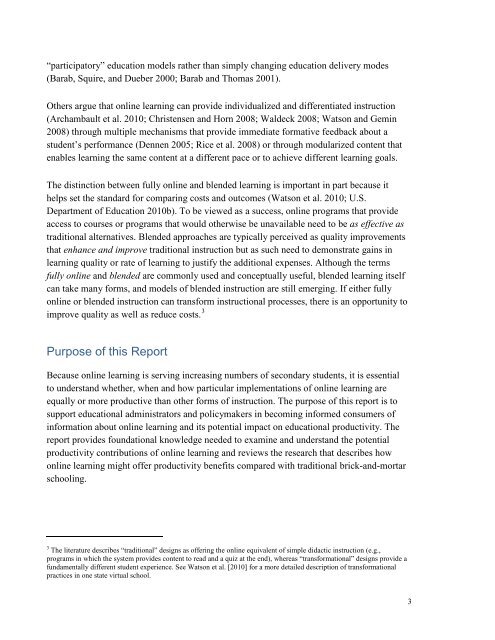Download PDF - SRI International
Download PDF - SRI International
Download PDF - SRI International
You also want an ePaper? Increase the reach of your titles
YUMPU automatically turns print PDFs into web optimized ePapers that Google loves.
“participatory” education models rather than simply changing education delivery modes<br />
(Barab, Squire, and Dueber 2000; Barab and Thomas 2001).<br />
Others argue that online learning can provide individualized and differentiated instruction<br />
(Archambault et al. 2010; Christensen and Horn 2008; Waldeck 2008; Watson and Gemin<br />
2008) through multiple mechanisms that provide immediate formative feedback about a<br />
student’s performance (Dennen 2005; Rice et al. 2008) or through modularized content that<br />
enables learning the same content at a different pace or to achieve different learning goals.<br />
The distinction between fully online and blended learning is important in part because it<br />
helps set the standard for comparing costs and outcomes (Watson et al. 2010; U.S.<br />
Department of Education 2010b). To be viewed as a success, online programs that provide<br />
access to courses or programs that would otherwise be unavailable need to be as effective as<br />
traditional alternatives. Blended approaches are typically perceived as quality improvements<br />
that enhance and improve traditional instruction but as such need to demonstrate gains in<br />
learning quality or rate of learning to justify the additional expenses. Although the terms<br />
fully online and blended are commonly used and conceptually useful, blended learning itself<br />
can take many forms, and models of blended instruction are still emerging. If either fully<br />
online or blended instruction can transform instructional processes, there is an opportunity to<br />
improve quality as well as reduce costs. 3<br />
Purpose of this Report<br />
Because online learning is serving increasing numbers of secondary students, it is essential<br />
to understand whether, when and how particular implementations of online learning are<br />
equally or more productive than other forms of instruction. The purpose of this report is to<br />
support educational administrators and policymakers in becoming informed consumers of<br />
information about online learning and its potential impact on educational productivity. The<br />
report provides foundational knowledge needed to examine and understand the potential<br />
productivity contributions of online learning and reviews the research that describes how<br />
online learning might offer productivity benefits compared with traditional brick-and-mortar<br />
schooling.<br />
3 The literature describes “traditional” designs as offering the online equivalent of simple didactic instruction (e.g.,<br />
programs in which the system provides content to read and a quiz at the end), whereas “transformational” designs provide a<br />
fundamentally different student experience. See Watson et al. [2010] for a more detailed description of transformational<br />
practices in one state virtual school.<br />
3
















